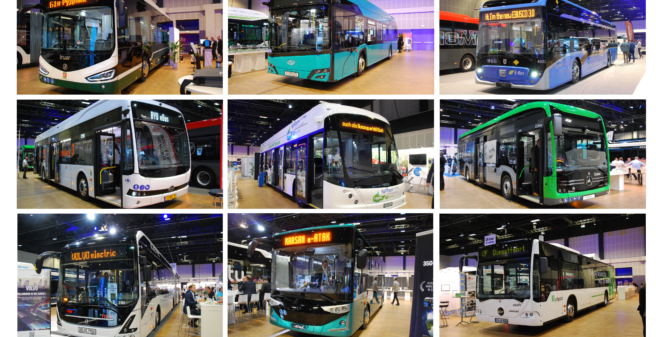
On 12 and 13 July, the Electric Bus Conference of the Association of German Transport Companies (VDV) took place in Berlin. The conference showcases information about the use and application possibilities of electric buses, about the latest technical progress in terms of vehicle developments, the respective advantages of battery and fuel cell buses … This year, for example, one forum of the conference was dedicated to the topic of “Fire protection in battery buses”. Without going into detail about the results of the forum here, this much can be said in summary:
- Fires in battery buses happen less often than in diesel buses
- Fires in battery buses are more difficult to extinguish than in diesel buses because the battery keeps producing the oxygen that keeps the fire alive. And so it continues to burn. What is a possible remedy? Park the buses so far away from each other that the flames cannot spread from one bus to the other.
There were also several other forums. The author also participated in the forums on the hydrogen bus and the trolley bus.
This brief overview may show that the topic of electric buses is considered very comprehensively at these VDV conferences. The speakers left no doubt that the electric bus is not only coming, but that it must come. “Otherwise we will not be able to achieve our climate targets”.
Another thesis from this year’s electric bus conference: “The autonomously driving bus will and must also come.” The reasoning behind this statement is as follows: we want to significantly expand public transport services to counteract climate change. To do so, more buses need to run in order to replace private cars. At the same time, less people want to work as bus drivers – and not only for buses, but also for trains. “If fewer and fewer people want to work as drivers, then the bus must be able to do it on its own”.
Parallel to the conference, the exhibition called “Elekbu” is also being organised, where the industry shows what it offers in the field of electric buses. The e-bus exhibits will be presented as follows:
BYD
One of the largest and oldest manufacturers of electric buses has long been the Chinese company BYD (Build Your Dream). In the meantime, more than 70,000 electric buses have been delivered worldwide. BYD has its European headquarters in Rotterdam, the Netherlands. Back in 2012, 10 years ago, a 12-metre-long electric bus was lent to the Bonn public utility company as a demonstration vehicle, which was tested for a month on line 630. The line was chosen with care, because it not only has a long route, but also sometimes goes up a hill – and back down again. The bus did what it was supposed to do. In particular, its range was quite convincing, although it was not designed for recharging on the line, but only for overnight recharging at the depot. The problem with the bus was quite different: its batteries were too heavy. Despite its 12-metre length, it was only allowed to carry 60 passengers – which is very little for a 12-metre bus – but otherwise it would have been overloaded. And there was another small problem: the language barrier. You would think that a manufacturer who wants to sell in Europe would at least have employees who speak English. Unfortunately, this problem persists to this day: at Elekbu, the author asked for an USB stick with the press documents. Three young Chinese women also made every effort to meet his wishes, but communication did not work. We finally agreed that it should be a USB stick. In the evening at the hotel, it turned out that this USB stick was virgin: there was nothing on it. BYD might have to work a little on the language problem …
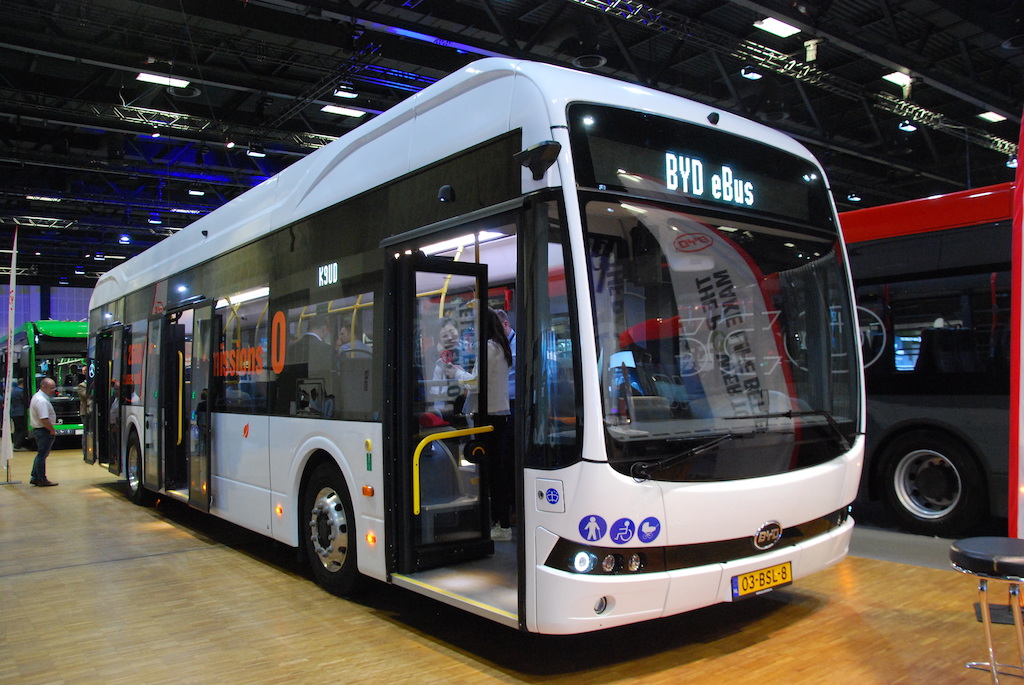
At Elekbu, BYD showed its 12-metre-long “eBus-12”, of course in its latest version. The “eBus-12” from BYD has been around for a long time, and it is not unknown here in Germany either. HCR from Herne (Herne – Castrop-Rauxel tramway) has two buses of this type, neighbouring company Bogestra from Bochum even 20. Five BYD eBus-12s are also running in the DB Group. BYD emphasises that it has already been able to sell a total of 2,700 of its electric buses in Europe, which are in use in over 100 cities such as Amsterdam, London and Oslo. They have already covered more than 179 million kilometres in Europe and have not emitted 192,000 tonnes of CO2.
The BYD eBus-12 is offered as a two- or three-door model. It has 422 kWh lithium iron phosphate (LiFePh) batteries, which give it a range of around 400 kilometres. Recharging on the line is therefore not necessary; the BYD is designed for over-night charging at the depot. And BYD emphasises that it already has 22 years of experience with these batteries. When this battery technology was still new, they were one of the pioneers when it was introduced to the market.
Caetano
Caetano from Portugal showed its fuel cell bus of the type “H 2 City Gold”. The vehicle was not entirely unknown, as it has already been shown as a demonstration vehicle. For example, at the beginning of the year it was with Regionalverkehr Köln (RVK), which used it on behalf of Bonn’s SWB on its SB 60 airport line between Cologne Central Station and Cologne/Bonn Airport via the A 59 motorway. For this line, its range, which Caetano puts at 400 kilometres, and the possibility of refuelling in a short time at the hydrogen filling station at the airport made it the ideal choice, as the line covers a daily distance of more than 600 kilometres. Battery buses are not yet ready to do that … – feedback from the test run in Bonn was quite positive.
The Caetano H 2 City Gold is a little bit less than 11 metres long and can be delivered as a two- or three-door vehicle. It can carry 64 passengers. It is powered by a synchronous Siemens Permanent-Magnet motor with an output of 180 kW (equivalent to 245 hp), and its fuel cell with an output of 60 kW comes from Toyota.
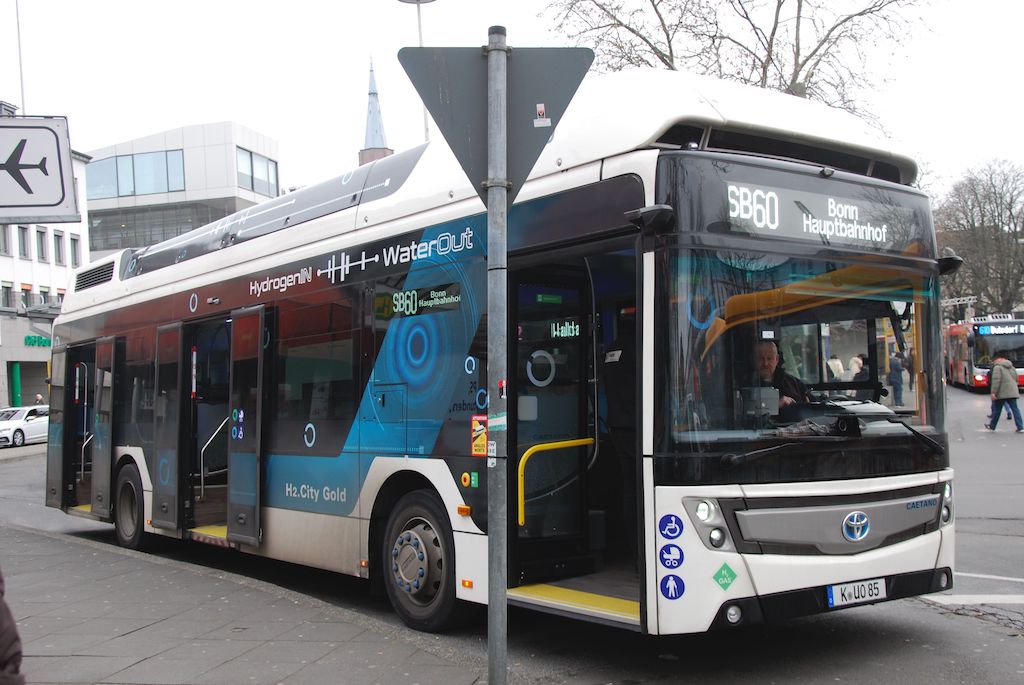
The hydrogen is stored at a pressure of 350 bar in five tanks made of composite plastic, each containing 312 litres – equivalent to 37.5 kilograms – on the roof. Caetano estimates consumption at 6 kg per 100 kilometres. Refuelling the completely empty bus takes less than nine minutes. Caetano uses lithium titanate oxide (LTO) accumulators as storage batteries.
CL (Clean Logistics)
The third exhibitor in the alphabet at Elekbu was a real surprise: CL (Clean Logistics) from Hamburg (administration) and Winsen/Luhe (factory). Under the type name “Pyuron” the company showed a six-year-old Mercedes-Benz Citaro of the Uckermärkische Verkehrs Gesellschaft from Schwedt, which has been converted to a hydrogen bus with fuel cell. This bus is CL’s first work, but the stand said that the second bus was already in the works. They also announced that they will convert diesel buses to battery buses in the future. – One thing is remarkable: the new drive technologies for buses are also producing new bus manufacturers.
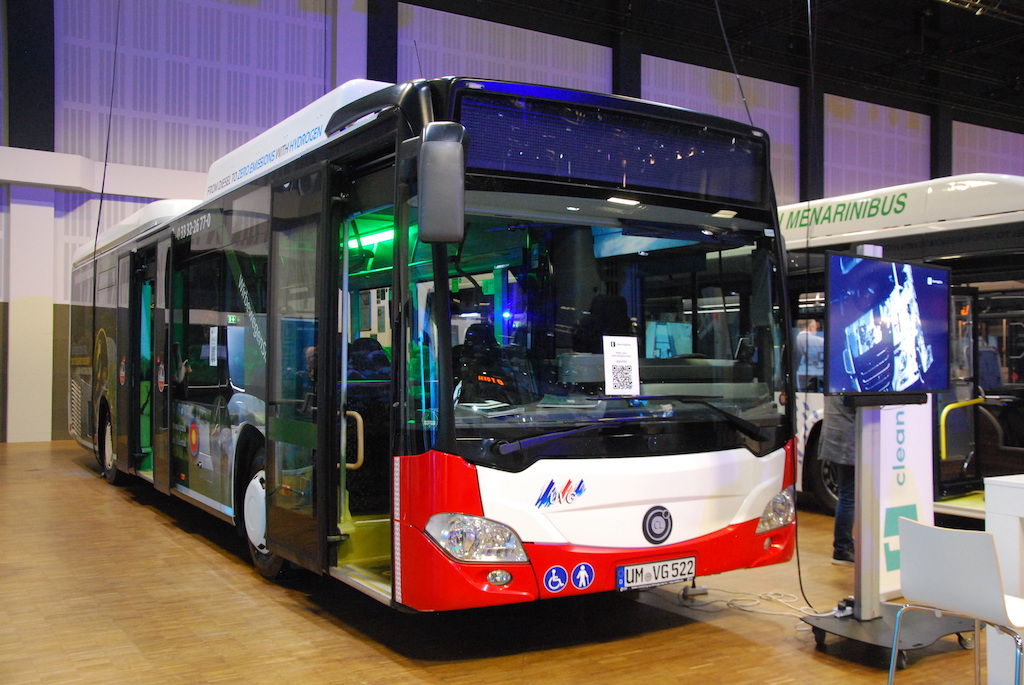
CL buys GINAF
In the meantime, it has been announced that CL has completely taken over the Dutch special truck manufacturer GINAF. With this step, CL intends to strengthen its position in the commercial vehicle market in the long term.
Ebusco
Ebusco showed two buses at its booth. The first was the 3041 of the Münchener Verkehrs Gesellschaft, a representative of the company’s latest development, which was very consciously designed for a low weight and whose body is therefore made of the composite material “Composite”. The empty weight of the Ebusco 3.0 is 33% less than that of a conventional steel bus. And Ebusco states that its range is up to 575 kilometres, which is truly remarkable. Gone are the days when recharging was often necessary. More and more, the Ebusco 3.0 is gaining importance in the sales of buses from this Dutch manufacturer.
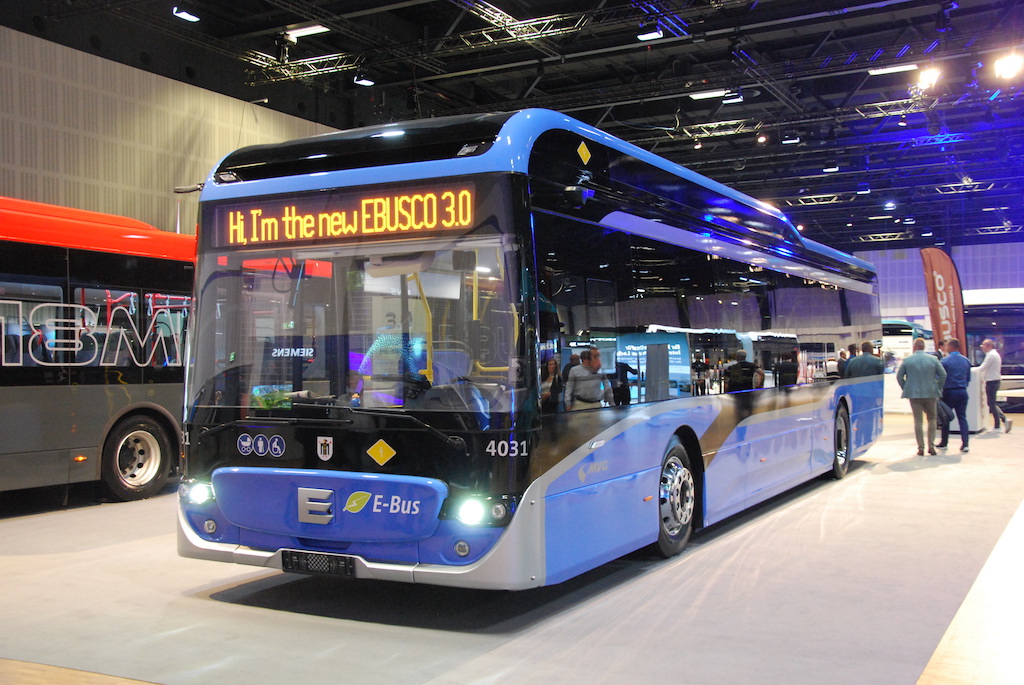
The second bus was an 18-metre long Ebusco 2.2 articulated bus, which was shown in the livery of the Dutch “R-Net” (Amsterdam region). It is still a conventional bus made of steel and can carry up to 150 passengers at a length of 18,000 mm. For the time being, that is more than respectable for an electric articulated bus. Its unladen weight is 19,000 kg and its batteries are lithium iron phosphate (LFP) accumulators. Depending on the battery pack chosen, its range is 350 to 450 kilometres. (The difference to the significantly lighter Ebusco 3.0 made of composite is considerable).
Ebusco expands to Cléon (France)
And another news: on the morning of 22 July, Ebusco announced that it had rented 21,000 square metres of space at the Renault plant in Cléon near Rouen. This is where Ebusco’s French headquarters will be located and where the Ebusco buses for France and south-western Europe will be built. Production is to start as early as next year, namely at the end of 2023, and it will initially be designed for 500 buses per year. Ebusco is investing 10 million euros to prepare the plant for its purposes.
Renault manufactures electric motors for its buses in Cléon. Ebusco, the electric bus manufacturer, expects synergy effects between the two manufacturers from its involvement in this plant. Renault could also benefit from Ebusco’s experience in the use of lightweight materials in vehicle construction (the “Ebusco 3.0” with its composite body).
Hess
Carrosserie Hess AG from Bellach in Switzerland (in the canton of Solothurn) showed its “LighTram 12 Plug”. Its body is made of aluminium, which is not welded, but screwed and glued according to the “CoBolt” system patented for Hess. Hess emphasises the advantage of this system, because damaged elements of the body can thus be replaced very easily: loosen the screws of the damaged element, remove the damaged element, insert the new element and screw it back on – and the whole damage case is closed.
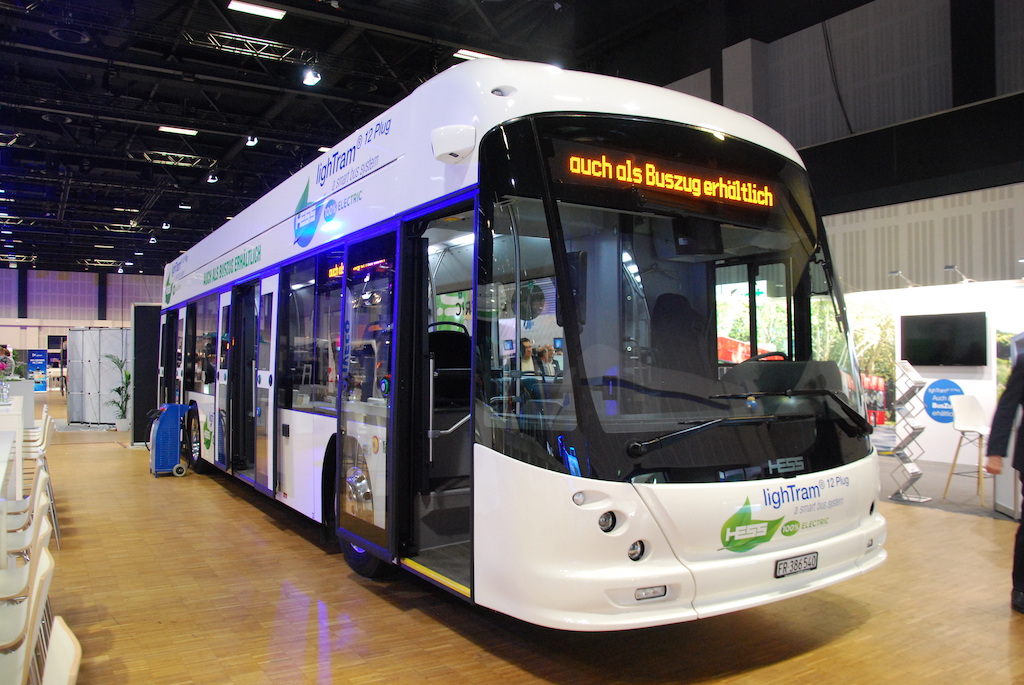
Hess likes to give its electric buses a tram-like design. This is also the case with its “LighTram 12 Plug”. Hess likes to “hide” not only the wheels of the rear axle, but also those of the front axle behind a cover. Wait, shouldn’t this cover turn with the wheel? Well, with the rear axle this is easy to avoid, because the cover is not attached to the wheel, but directly to the bodywork in front of and behind it. But that’s not possible with the front axle, because the wheel has to be able to move freely, it has to be able to turn in curves … Question to Hess: how did you solve this? The answer: In the middle of the hub there is a core that does not turn with the wheel, and we attach the cover to this core. This way it swivels in with the wheel, but does not rotate with it and always remains horizontal.
The bus shown was a three-door with narrow front door and wide doors in the middle and in the rear. The narrow front door may be a consequence of the “tram look” with a very slanted front … It offers space for 81 passengers, 25 of whom find a seat. It is powered by liquid-cooled permanent magnet engines.
Irizar
Irizar from Spain is the market leader in its home country with a market share of about 40 %. The company showed a 12-metre battery bus of their type “ieBus 12”. The vehicle was labelled in Cyrillic letters, which had the “advantage” that one could not read for which customer it was intended. Since Irizar received a larger order for 33 ieBus 12s from the Bulgarian city of Stara Zagora, the wagon shown probably belongs to this order.
Irizar’s sales partner in Germany is Ferrostaal in Essen. They have already lent demonstration buses from there, for example to Bonn, but also to the Essen-Mülheim Ruhrbahn. In Bonn, the bus ran for a month on line 630 (see also above under BYD) – with return and return trips to and from the Friesdorf depot as line 631.
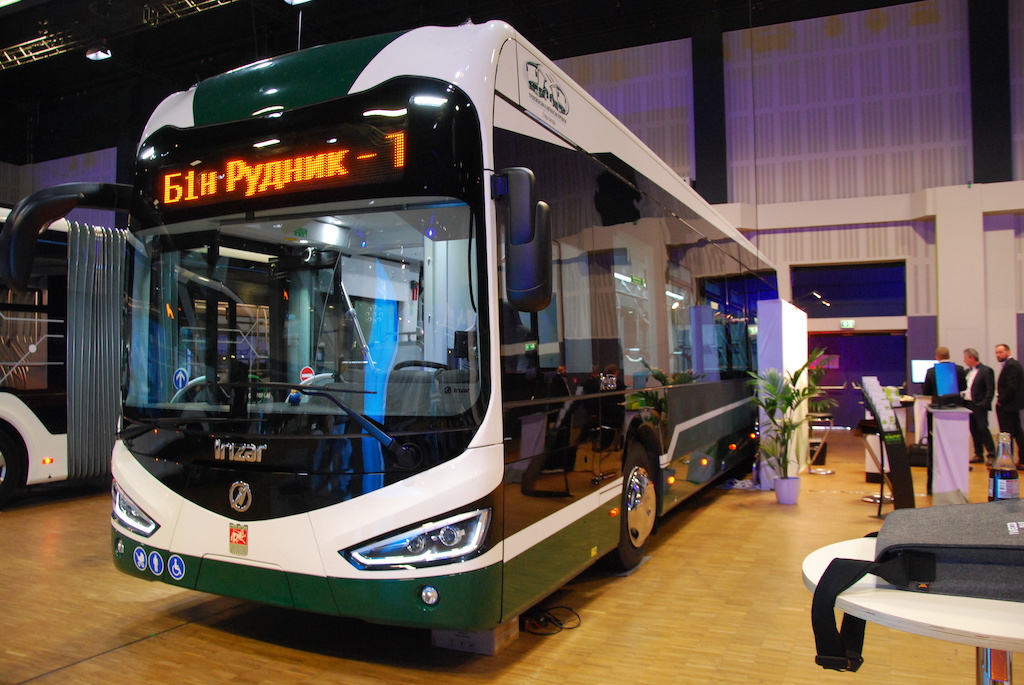
Above all, Irizar has already completed a major order from Germany. Ten Irizar ieBus 12 (Rheinbahn coaches 6001 to 6010) went to the Düsseldorf Rheinbahn. And Irizar has already received a repeat order for eight more coaches.
With a battery capacity of 350 kWh, the ieBus 12 has a range of around 250 kilometres. It is recharged as a depot charger via CCS combo plugs.
Iveco
Iveco showed its 12-metre-long, three-door “E-Way 12”. It is built in Rorthais in the north-east of France in the plant that has become known as the factory of the vehicle manufacturer Heuliez, founded in 1920. Since the turn of the millennium, Heuliez has belonged to the Iveco Group, initially as a sister of Iveco Commercial Vehicles under the umbrella of the joint parent company “Case New Holland”, which belongs to the Iveco Group, and since a recent reorganisation of the Group as part of Iveco Commercial Vehicles.
The E-Way 12 is offered with nickel-manganese-cobalt (NMC) or lithium-titanate-oxide (LTO) batteries, according to customer requirements. The former are accumulators with a high energy content, the latter are characterised by high performance.
Iveco offers its E-Way either as a depot charger (slow charging overnight at the depot) or for fast recharging on the line by means of a pantograph, whereby both types of pantograph are possible here: both the one that rises from the roof of the bus to the charging station and the one that lowers from the charging station onto the bus (“inverted pantograph”).
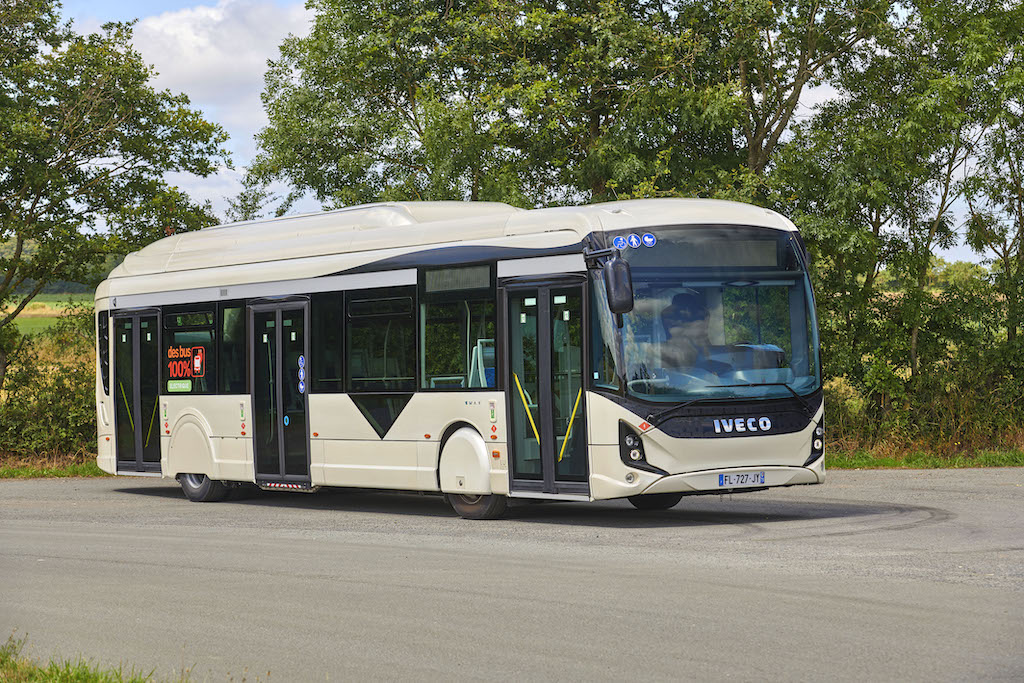
The number of seats in the E-Way 12 depends on how large the “special use area” (for wheelchairs, prams, but also standing passengers) is in the area of the centre door that the customer has chosen. But even in a version with a very large special use area, the E-Way 12 offers at least 24 seats.
The bus has an unladen weight of 13,835 kg and – in the European Union – a permissible total weight of 19,000 kg (elsewhere it may also be 20,000 kg). But even in the EU, the permitted load is more than five tonnes – exactly 5,165 kg.
Just as an aside, Iveco was awarded a prize for good design last year for its E-Way. Its design concept also includes the clad front and rear axles. Typical for Heuliez are the additional windows below (!) the normal lower edge of the windows, which ensure that a lot of light enters the vehicle, making it very bright and friendly inside.
K-Bus
In 1986, the bus entrepreneur Stefan Kutsenits from Hornstein in the Austrian Burgenland founded his own bus production. The first production hall was built in Hornstein. The first Kutsenits buses were superstructures on Mercedes-Benz chassis such as the O 814 Economy (successor to the O 309).
With the collapse of Yugoslavia, the opportunity arose to take over a factory in Murska Sobota, Slovenia, with a hall area of 4,000 sqm on a plot of 12,000 sqm. The town lies on the River Mur, which here forms the border with Austria: on the opposite bank is Austrian Styria.
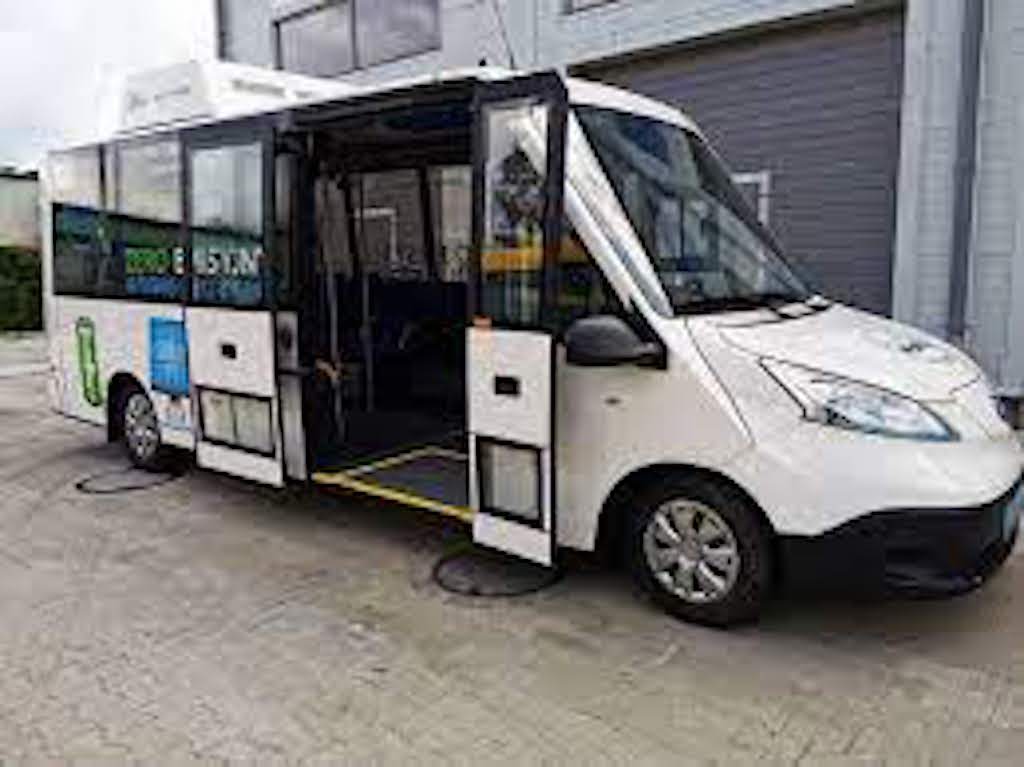
Production was expanded to include vehicles based on Volkswagen models, and the Hydra-City, a completely independently developed self-supporting bus with hydraulic drive, was added, some of which were also sold in Germany (Stadtverkehr Bad Wörishofen) and Sweden.
In the meantime, K-Bus (as Kutsenits has called itself for some years now) offers a very diverse product portfolio. Sometimes the look of the K-buses bears a certain resemblance to the Sprinter types from Mercedes-Benz …
At Elekbu they showed a bus of their type “e-Solar City”. The 100 percent low-floor bus is based on the “e-NV 200” from Nissan. It has a range of 110 to 150 kilometres. Solar cells are mounted on its roof, which have the function of a “range extender” and can increase its range by another 110 to 130 kilometres. – The battery and solar system have a capacity of 48 kWh.
Depending on the equipment, the trolley can carry between 20 and 32 people. Its maximum permissible total weight is 5,500 kg.
Karsan
Karsan from Turkey is increasingly becoming a global player. Karsan buses have long been on the road all over Europe, and orders have recently been received from the USA and Canada. According to the company, the administration is based in Istanbul, the factory is in Bursa in the European part of Turkey. – The name of the company: “Kar” is the Turkish word for coach, “San” is a Turkish abbreviation for company …
Karsan is one of the manufacturers who are vigorously pushing the development of the bus. For example, they recently delivered a fully autonomous bus of their type “eATAK” to Stavanger in Norway (UTM reported) and are thus “one step ahead” (that is Karsan’s motto) compared to their competitors.
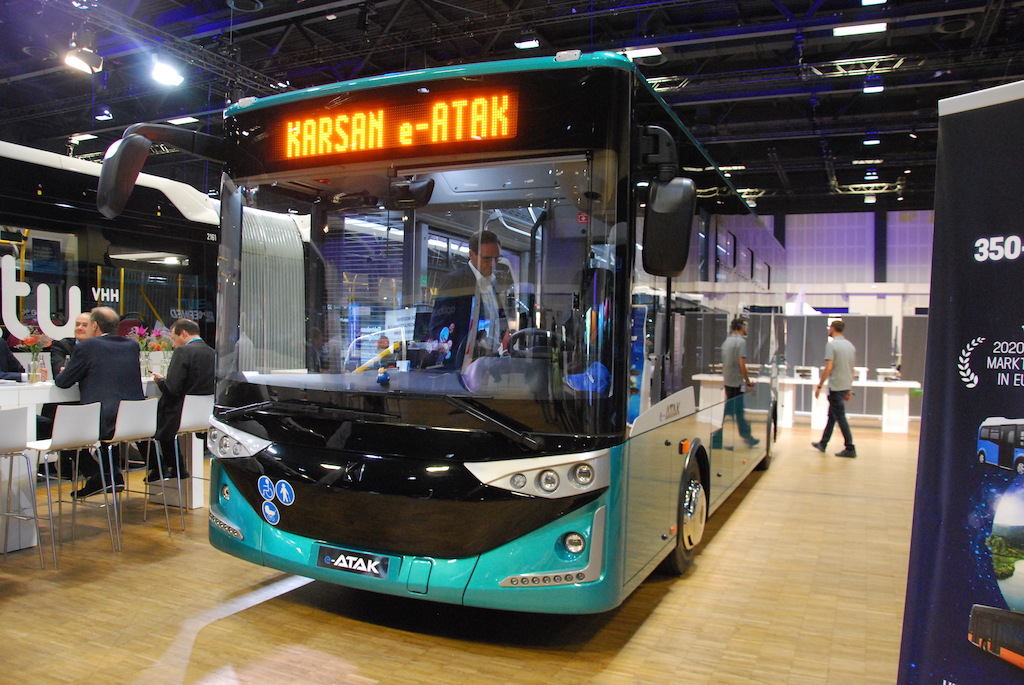
At the Elekbu in Berlin, they had brought one bus each of their types “eJEST” and “eATAK”. The “eJEST” is best described as an electric minibus, the “eATAK” as an electric midibus. Both use the electric drive technology, in particular the electric motor of the BMW i3, which the Bavarian bus manufacturer installs in its electric buses. The lithium-ion batteries also come from BMW. Both the “eJEST” and the “eATAK” are designed as depot chargers; recharging is done via a CCS combo plug, which in the case of the eJEST is located in the front mask of the bus.
The “eJEST” is 5.8 metres long, can carry a maximum of 25 passengers and has a range of an impressive 210 kilometres.
Karsan is particularly proud of the independent suspension on all four wheels, which gives the bus very comfortable handling characteristics.
As a second exhibit, Karsan showed its electric midibus “eATAK”. It is 8 meters long, can carry up to 52 passengers and has a maximum range of 300 kilometers. Its electric motor has an output of 230 kW (equivalent to 313 hp) and promises a range of 300 kilometers. The connection for the CCS combo plug for reloading is located on the front right side panel of the bus.
But Karsan has long been active in the field of “full-fledged” electric buses. The “eATA” series with trolleys in lengths of 8, 10, 12 and 18 meters has been available since last autumn.
LibroDuct
LibroDuct from Saarbrücken does not offer buses, but a very useful “accessory” for all buses that have to do with catenary. These are not just conventional trolleybuses, but also battery-operated trolleybuses (so-called in-motion chargers), which the Solingen municipal works have recently procured and will only procure in the future.
This useful “accessory” is a procedure by which an electric bus can place its trolley poles on the catenary at any point of the catenary completely independently and automatically. There is no need for a “railing” funnel in the catenary, as Solingen is currently using, and the driver certainly doesn’t have to attach the poles to the catenary with a rope or hook … No, the bus can do it all by itself, and as already mentioned any point of the overhead line.
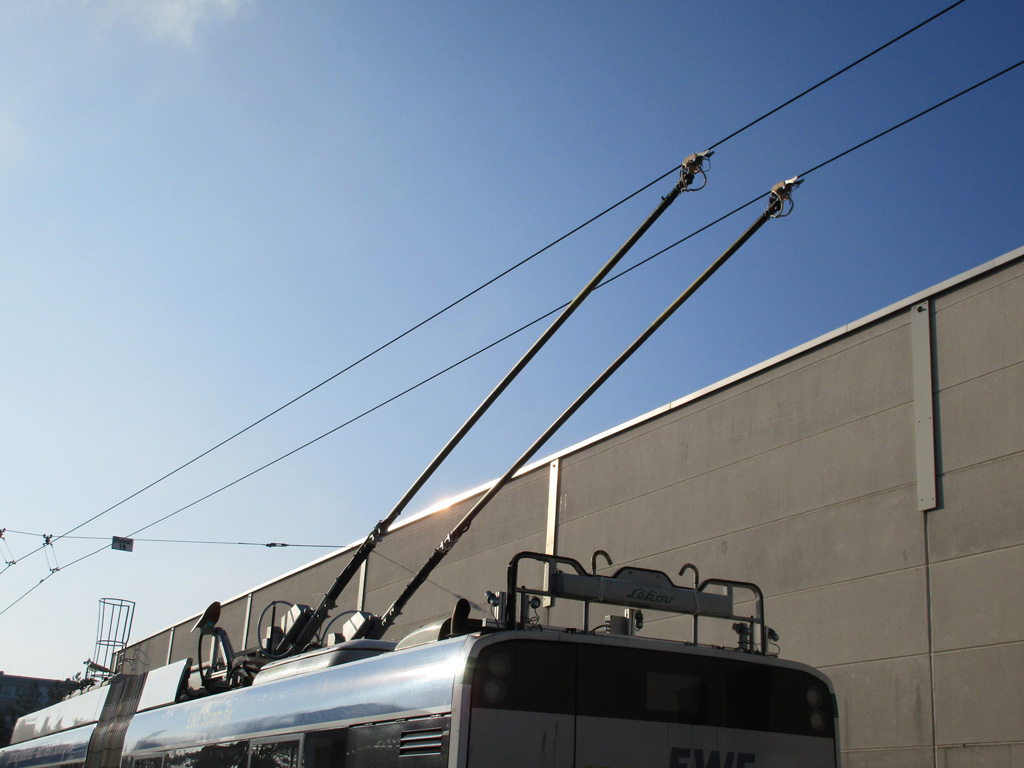
A demonstration mockup was set up on the Elekbu with two pairs of contact wires stretched over them. And it was impressive to see how the trolley rods actually climbed up to the left and then to the right pair of lines all by themselves, reliably found contact, and how small metal elements closed on the current pickup shoe of the rods to make a rod derailment impossible.
And how does it all work? Well, on the roof of the bus, cameras are mounted to the right and left of the two trolley poles, which swivel with the poles and compare whether the pole actually reaches its contact wire. If it doesn’t, the system automatically corrects it.
LibroDuct says this saves electricity. And battery trolleybuses also need less accumulator capacity because they can be disconnected and, above all, reconnected at any time and at any point in the network.
This LibroDuct system could become important if the “Spandauer trolleybus network” in Berlin were actually to be implemented in the way it was presented at the 2019 Electrobus Conference. At that time it was said that a very uncomplicated catenary was to be braced. No catenary where switches or crossings would be necessary, no catenary over less frequented line sections … It sounds as if the rods often had to be removed and put back on again. And that is exactly what LibroDuct could do optimally and without wasting time…
MAN
MAN, along with Navistar, Rio, Scania and Volkswagen Truck & Bus (South America) one of the subsidiaries of Traton SE (SE = Société Européenne – European company), which belongs to the Volkswagen Group, presented its 18-meter-long electric articulated bus at the exhibition in Berlin of the type “Lion’s City 18 E”. The vehicle has had some success on the market, especially since not every manufacturer of battery buses is really that far with an articulated battery bus.
The bus is available with three or four doors. The four-door variant is becoming increasingly popular. On the one hand, this is because the four-door does not have to stand at the bus stop for so long to change passengers, but on the other hand, because instead of the four seats that are lost for the additional door, there is more standing room.
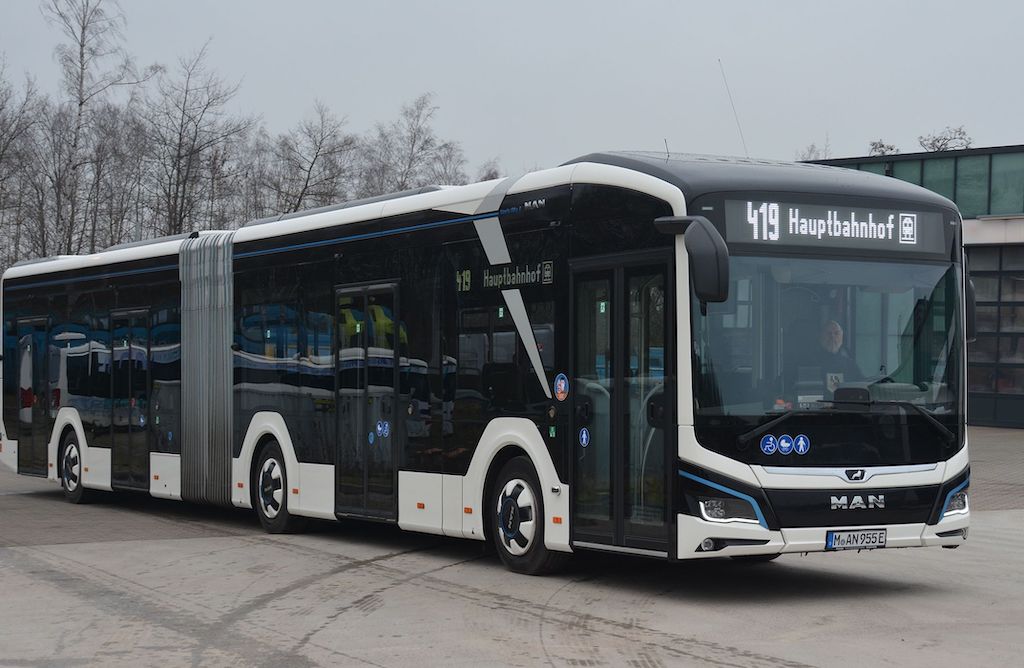
The Lion’s City 18 E is 18,100 mm long and offers 45 seats. It is driven on axles 2 and 3 by an electric central motor. It stores its driving current in nickel-manganese-cobalt batteries (NMC) with a capacity of up to 640 kWh, which give it a range of around 350 kilometers.
MAN was able to book its first major order for its electric articulated bus with 39 vehicles for VAG Nuremberg. Other companies have long since joined. Braunschweiger Verkehrs GmbH (BSVG) successfully tested a Lion’s City 18 E in its regular service in the spring. And remarkable customer comes from the island of Sylt: Here, the Sylter Verkehrsgesellschaft, previously a stronghold for buses from the competitors Mercedes-Benz (articulated bus) and Van Hool (double-decker) ordered electric articulated buses of the “Lion’s City 18 E” type from MAN , which are to be delivered next spring.
Menarinibus
Noteworthy was the participation of Menarinibus from Italy in the exhibition. A 12 meter long bus of its type “Citymood 12 e” was shown.
Menarini has not been an unknown name among bus builders for a long time. The company was founded in Bologna in 1919 as “Carrozzeria Menarini”. Anyone who has ever vacationed in Italy knows buses from Menarini. In South Tyrol (Alto Adige) the author (Società Automobilista Dolomiti – Südtiroler Autobus Dienst) drove (had) quite a few Menarini, and he remembered the buses as comfortable intercity vehicles. For example, the seats reminded him more of those on a coach…
Around the turn of the millennium, Menarinibus was taken over by the mechanical engineering company Breda, and from then on it was known as “BredaMenarinibus”. That remained so until 2015. Then there were new owners at Menarini: 80% of them were the Chinese bus manufacturer King Long and 20% the Italian company Leonardo. The name “Breda” disappeared again from the company name. With “Padane”, a well-known name from Italian bus construction has been reactivated.
Today Menarini belongs to the “Industria Italiana Autobus”, in short: IIA. It was created in 2019, its owners are:
- Leonardo: 20.07 %
- the Turkish bus manufacturer Karsan: 20.03 %
- the public investment firm „Invitalia“ zu 29.95 %
- another investment firm with 29.95 %.
This means that “Industria Italiana Autobus” is 79.97% in Italian hands.
After this excursion into the company history of Menarini, let’s come to the bus that was standing there in the exhibition hall. It is 12,100 mm long and 2,550 mm wide, which is standard today. Its height is 3,250 mm. It is available as both a two- and three-door variant, with the two-door variant being more of a concession to our Central European taste: in Italy, people like to have many doors. Unforgotten are those Italian city buses that had four double-width doors over a length of 12 meters – the right side of the bus, apart from the area of the two axles, consisted almost entirely of doors. – The carriage can be furnished with 24 to 28 seats, depending on the customer’s requirements.
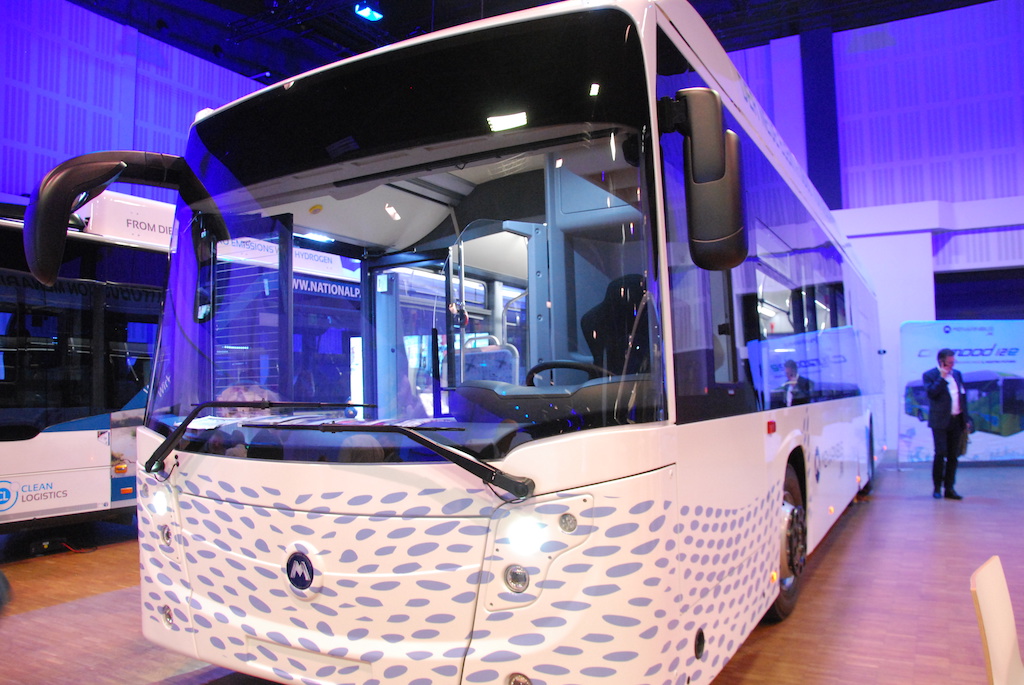
The Citymood 12 e’s lithium-ion nickel-manganese-cobalt batteries (NMC) have a capacity of 294, 392 or 490 kWh, depending on the customer’s requirements, and give it a range of 300 to 300 km with the largest capacity, according to IIA 350 kilometers. It is recharged via CCS combo plugs. The PEM ID 82016-6 N 806 electric motor from Siemens is installed lengthways in the rear and transmits its power to the rear axle.
The bus uses the RL 82 EC from ZF as the front axle and the portal axle AV 133 from ZF as the drive axle. The permissible total weight of the Citymood 12 e is 19,000 kg.
Mercedes-Benz
Mercedes showed bus 9525 of the ÜSTRA from Hanover on its stand. The bus is an eCitaro. It is part of the ÜSTRA project, with which all bus lines in the inner city area are to be converted to electric buses today. UTM reported here:
Daimler Truck, the commercial vehicle manufacturer with the star, is becoming a pioneer with its battery buses. While almost all electric buses today still have lithium-ion batteries, in which liquid and organic electrolytes (minerals) carry the charge, Mercedes is already working on installing solid-state batteries in its electric buses. In the solid-state battery (solid-state battery), the solid, ceramic electrolytes are arranged in thin layers one on top of the other. Mercedes is already delivering buses with this technology.
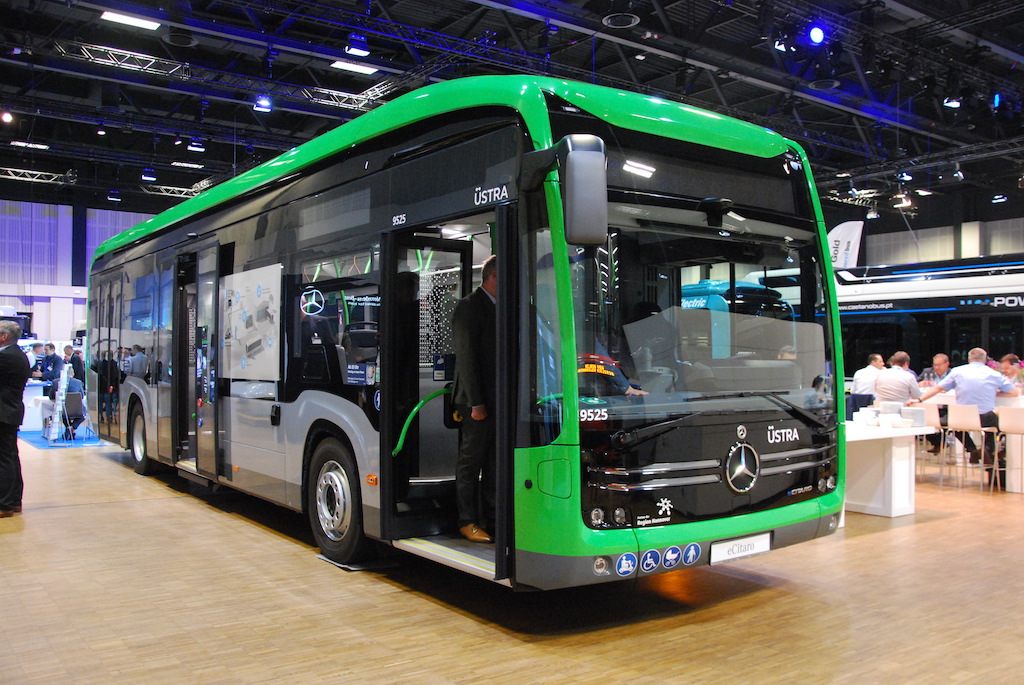
The solid-state batteries bring a whole range of advantages. First, they’re about 50% more sustainable to manufacture because they don’t use cobalt. A higher energy density gives the bus more power and therefore a longer range. Ranges of over 1,000 kilometers are possible, which even a bus with a modern combustion engine cannot achieve. Recharging is faster and the solid-state battery can handle 100,000 charging cycles, while a conventional lithium-ion battery only has around 30,000 charging cycles. This significantly increases battery life. After all, safety is significantly improved with solid-state batteries because they are much more difficult to catch fire.
The solid-state batteries that Mercedes is already installing in its electric buses currently come from the French manufacturer Bolloré. But that should not and will not remain the case: Mercedes is planning to build its own battery factory in the Esslingen district.
Otokar
Otokar (Otokar Otomotiv ve Savunma Sanayi A.S.), based in the city of Sakarya, is in some ways a typical Turkish bus manufacturer. Because the company was founded in 1963, at a time when several Turkish bus manufacturers were emerging. Otokar belongs to the Koc Group, .
The first bus to leave the factory was a licensed Magirus-Deutz touring coach. The bus looked confusingly similar to the original from the Mainz plant – you had to look very closely to see that it wasn’t an original Magirus. Otokar has also been supplying midibuses since the 1970s, and city buses were added in the 1980s.
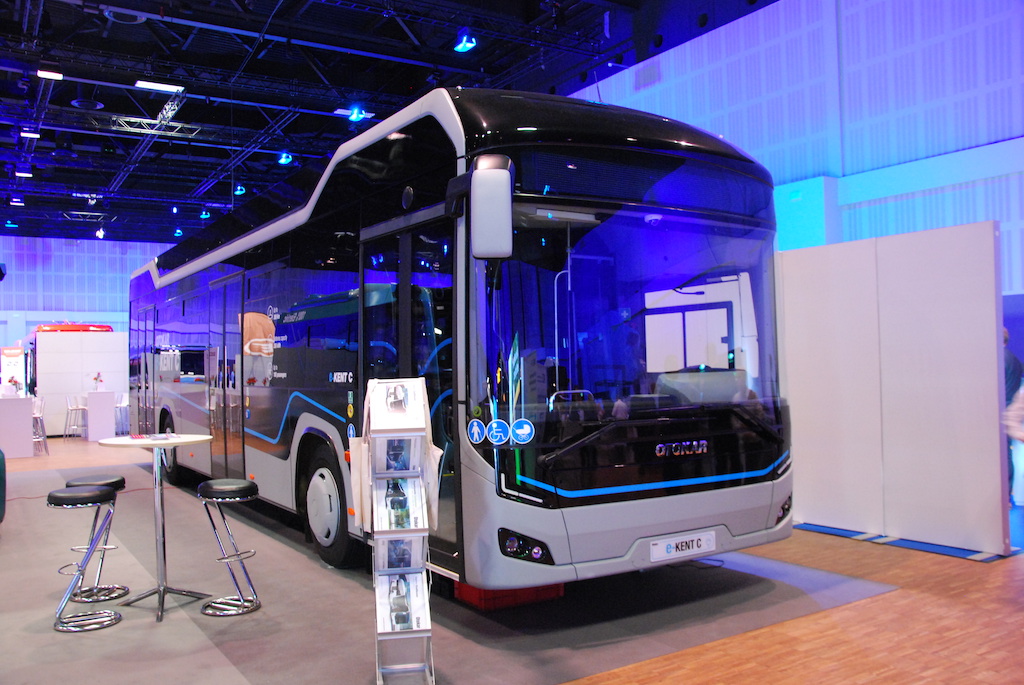
At the Elekbu in Berlin, Otokar showed two buses: the “eCentro C” midibus and the “full-grown” 12-meter “eKent C” bus.
The electric midi-city bus “eCentro C” from Otokar celebrated its German premiere at the “Bus2Bus” in Berlin in April. It has been available as a diesel bus with a Fiat engine since 2009. For the premiere as an electric bus, it has been optically revised, which “becomes its face”. At the front, his big “googly eyes” catch the eye, that is to say, the headlights in LED technology, which are really spherical.
The little one is 6,605 mm long, 2,453 mm wide and 2,868 mm high including air conditioning. It offers space for 32 passengers, ten of whom have a seat and a further six have a folding seat. There are also 16 standing places. The bus weighs 4,700 kg empty, so with a permissible total weight of 7,000 kg, its payload is 2,300 kg.
It is driven by the Dana TM 4 electric motor, a product from the USA. It is a permanent magnet synchronous motor arranged as a central motor. It has an output of 200 kW. That corresponds to 277 hp, and the bus is quite well motorised. It stores its driving current in lithium-ion batteries based on the chemical nickel-manganese-cobalt (NMC). They have found their place under the floor of the vehicle and thus in a position that has recently become more and more common in the construction of electric buses. An electric bus does not need nearly as much installation space for the engine as a diesel bus needs.
The front axle with independent wheel suspension comes from Otokar itself, the rigid drive axle is supplied by the Chinese manufacturer Qingdao Qingte.
Since last summer, the 12 meter long city bus Kent C from Otokar has also been available as an electric bus with the type designation “eKent C”. Although Kent sounds very British, it is nothing more than the Turkish term for city.
It is noteworthy that the lithium-ion batteries with nickel-manganese-cobalt chemistry (NMC) have been supplied by the automotive supplier Webasto. Each of them has a capacity of 35 kWh and up to ten of them can be installed on the roof and in the back of the bus, giving a total capacity of 350 kWh. Otokar specifies the range as around 300 kilometers. According to Otokar, the battery life is 10 years or 3,000 charge cycles.
Pepper Motion
We’ve known Pepper Motion for a long time, although not under that name. The company from Denkendorf in the Eichstätt district was founded under the name “etrofit” in 2017 and has specialized in converting buses (and also trucks) from diesel to electric drives with its 110 employees. In Berlin, a first-generation Mercedes Citaro was shown, which has been turned into an electric bus. (It is said to be the former bus 21 of the Pforzheim municipal works, built in 2005)
Pepper literally: “With our award-winning, series-ready retrofitting concept, we give your used commercial vehicle an environmentally friendly second life as an electric vehicle.” This is done with the help of a “kit” (assembly kit) that is TÜV-tested, which means the guarantee for the customer is that the converted bus meets European standards. Pepper does the conversion and makes sure that the bus is approved for road traffic again.
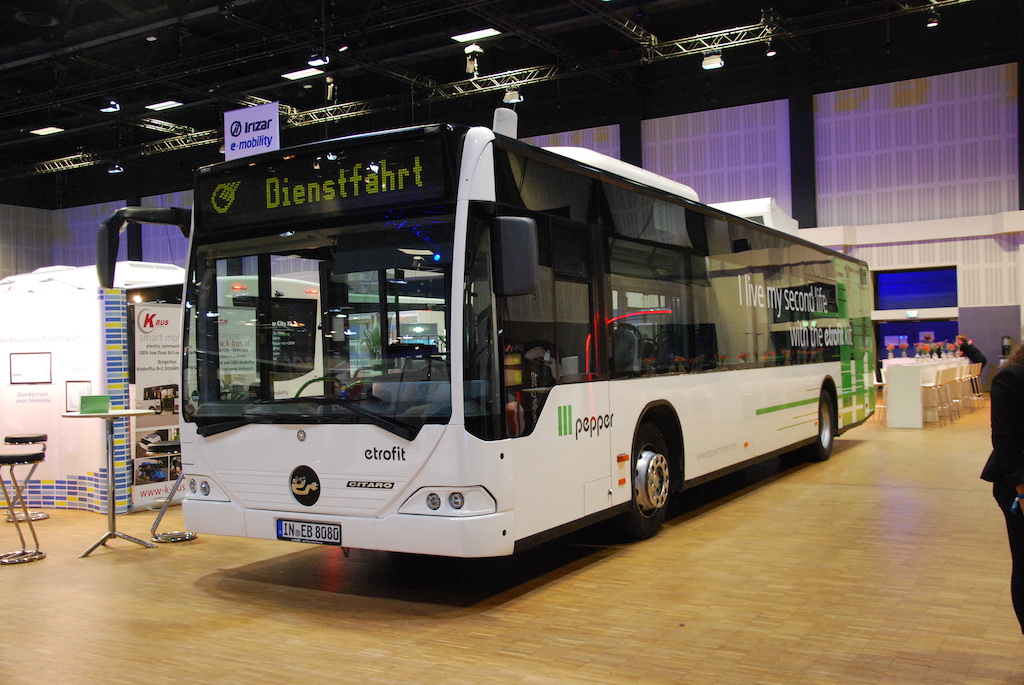
So far, Pepper has offered conversion kits for the 12-meter-long Mercedes-Benz Citaro of both the first and second generation. A kit for the low-entry versions of the Iveco Crossway will also be available shortly. (Anyone who has a bus of a different type or brand can look to other converters such as “I see buses” from Enge-Sande in Schleswig-Holstein or Quantron in Augsburg.) The conversion takes six to six months, depending on the general condition of the bus in question eight weeks, delivered five months after receipt of the order. You can accept orders at any time.
Pepper uses a modular lithium-ion battery pack based on NMC (nickel manganese cobalt). Each module has a capacity of 60 kWh, several modules can be interconnected, which increases the capacity accordingly. And Pepper says that a bus they convert has a range of around 250 kilometers.
Compared to a new diesel bus, a vehicle converted to an electric bus by Pepper saves the environment 68 tons of CO2 per year. And it saves its operator 144,000 euros in operating costs in ten years. Which means that the conversion pays off in any case.
Solaris
The Polish bus manufacturer Solaris is now part of the Spanish CAF Group. So it is not surprising that today the CEO (Chief Executive Officer) of Solaris is the Spaniard Javier Calleja.
Solaris is one of the pioneers in the field of electric buses. Already at the turn of the millennium, the then boss Krzysztof Olszewski said that the public transport of the future must and will be electric. The first electric buses were delivered to customers in 2014: a battery-powered midibus went to Klagenfurt to the local public utility company, Braunschweig put a 12-metre-long solo vehicle (carriage 1401) and five 18-metre-long articulated buses (carriages 1412 – 1415) into service. All of these buses were designed for recharging on the line, it was thought at the time that there was no other way to operate battery buses. Braunschweig opted for a very unconventional system of recharging, because they opted for Bombardier’s “Primove”, in which the bus stands above a charging station embedded in the roadway and during the normal stop (or at the main station during the break) inductively from below is reloaded. This system was still used in Berlin and Mannheim, meanwhile Braunschweig is the only company left with Bombardier Primove.
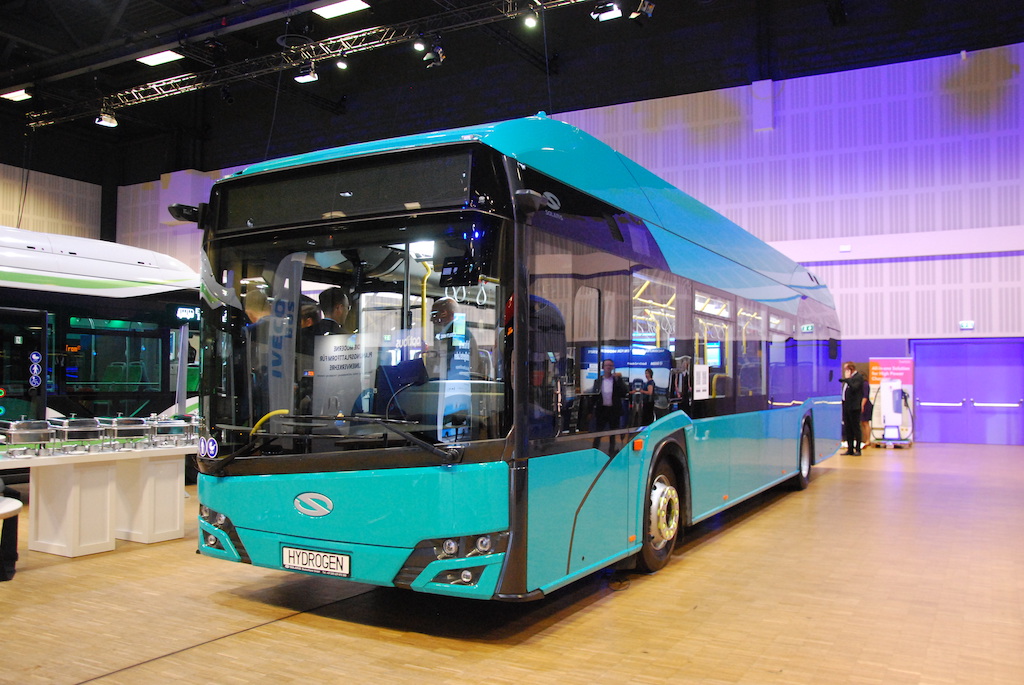
And although Braunschweiger Verkehrs GmbH repeatedly emphasizes that Primove works: the 55 electric buses for which the BSVG has just received the funding notice are to be depot chargers (overnight) that no longer need to be recharged on the route. This may show the advances battery technology has made in the eight years since 2014.
At the electric bus conference in Berlin, Solaris presented an “Urbino 12 hydrogen” that generates its own driving power by reacting hydrogen with the oxygen in the air in a “fuel cell”, which produces electricity. The bus on display was intended for the city’s “In-der-City-Bus” in Frankfurt am Main.
The “Solaris Urbino 12 hydrogen” has the AVE 130 from ZF as the drive axle and transfers its power to the road via two electric motors close to the wheels, each with an output of 110 kW – one on the right and left rear wheel. The fuel cell, in which the driving current is generated in “reverse” electrolysis, has an output of 70 kW. Solaris specifies the range of the bus as 350 kilometers. The hydrogen is carried in five 312 liter tanks made of composite material. Electricity is stored on board in lithium-ion batteries.
For the front axle, the customer can choose between the version with independent wheel suspension – the standard version – or a simpler rigid axle. The bus comes with the electronic braking system (EBS), the anti-lock braking system (ABS) and the anti-slip regulation (ASR) as standard, and the electronic stability control (ESC) is also available.
On September 14th, Solaris will officially present its first articulated hydrogen bus, the “Solaris Urbino 18 hydrogen”, in Krakow. The bus will be handed over to the city’s public transport company MPK. Solaris is once again a pioneer. Fuel cell articulated buses are nothing completely new – think of the APTS Phileas, two of which were operated by Regionalverkehr Köln, for example – but they are still extremely rare.
Volvo
The Swedish manufacturer – who is building its buses for the German market in Wroclaw, Poland – showed a bus of its Volvo 7,900 EA type with bus 2161 of the Hamburg – Holstein transport company. The “E” in the type designation naturally stands for the electric drive, the “A” is derived from the English word “articulated” for “joint”.
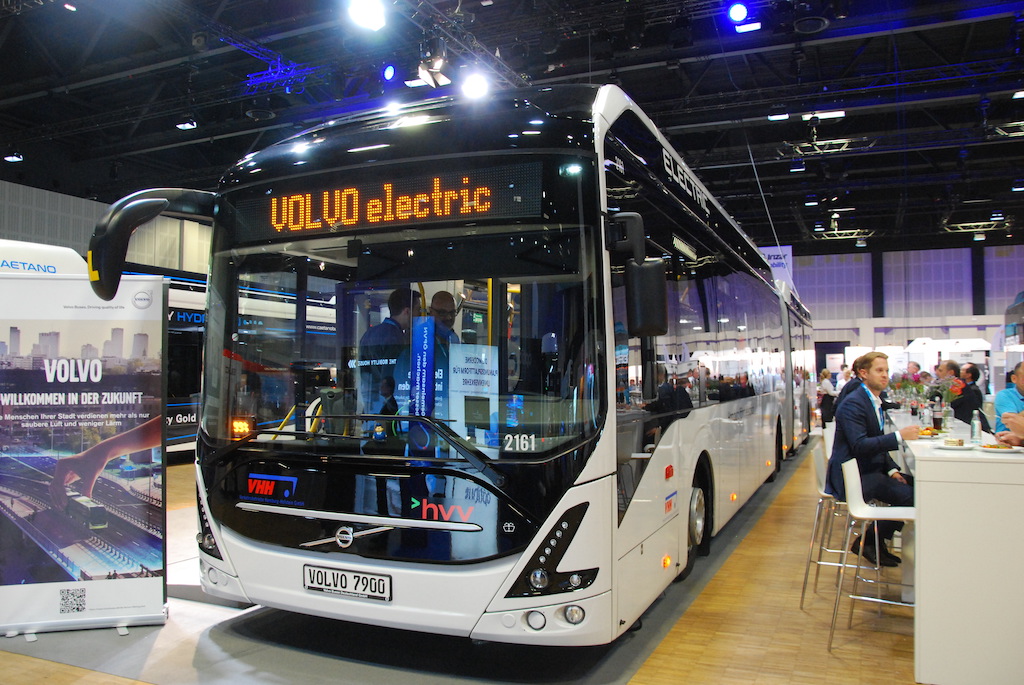
With a length of 18,557 mm, the articulated Volvo electric bus is slightly longer than most of its competitors. Volvo attests it a capacity of 150 passengers. In the rear they find something that was very popular in bus construction for a time: a conference or round seat group. The advantage of this detail is obvious: right at the back of the bus there are people who think they have to leave their “scent mark” with graffiti. And because you’re alone there and the other passengers don’t notice anything, nobody says anything. The conference group, on the other hand, can be viewed freely .,..
The Volvo 7,900 EA has a twin engine with an output of 397 kW (540 hp), which is positioned slightly to the left at the rear of the bus. Safety systems such as EBS, ABS and ASR are a matter of course.
According to a printed matter for the Hamburg Parliament, the wagons are stationed at the depot in Schenefeld and are recharged here overnight with CCS combo plugs. (This paper is in response to a question from a 2020 MP who actually preferred diesel to electric buses at the time.)
14.08.2022
